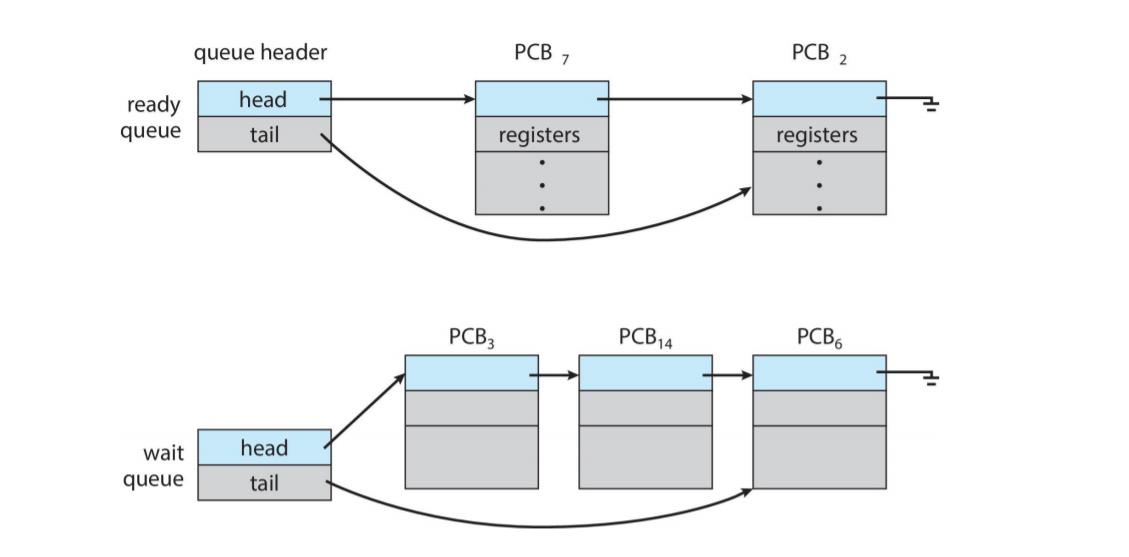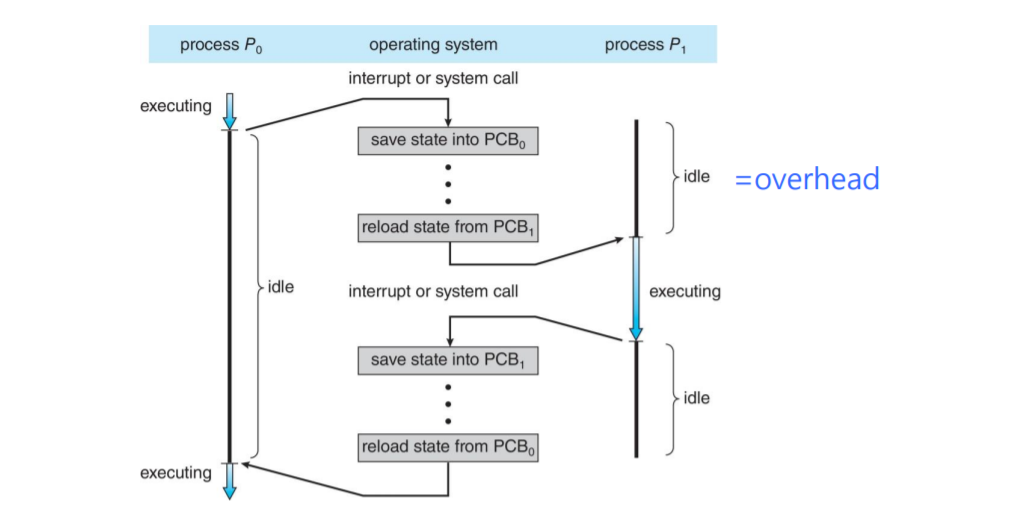👀 Process Scheduling
📕 objective of Process Scheduling
- The objective of multiprogramming is to have some
process running at all times, to maximize CPU utilization. - The objective of time sharing is to switch the CPU among processes so frequently that users can interact with each program while it is running.
-
To meet these objectives, the process scheduler selects an
available process for program execution on the CPU -
For a single-processor system, there will never be more
than one running process.
• The rest will have to wait until the CPU is free and can be rescheduled.
Summary
objective of Process Scheduling
- multiprogramming의 목적은 process를 항상 실행시켜, CPU사용률을 높이는 것이다.
- time sharing의 목적은 CPU를 process 간에 자주 전환하여 실행 중인 각 program과 상호 작용할 수 있도록 하는 것이다.
- 이 목적을 달성하기 위해, Process Scheduler가 CPU에서 program 실행에 사용할 수 있는 process를 선택한다.
- single-processor system에서는 process가 한 개 이상 실행될 수 없다. 만일 process가 여러개 있다면, 나머지 process들은 다시 Schedule 될 때까지 대기해야 합니다.
📙 Process Scheduling Queues
- Processes migrate among the various queues for process scheduling
Ready queue
- set of all processes residing in main memory, ready and waiting to execute
• Generally stored as a linked list; each PCB includes a pointer field that points to the next PCB
wait queue
- Processes that are waiting for a certain event to
occur, ex. completion of I/O

Summary
- Process들은 process scheduling에 따라 다양한 queue들 사이를 옮겨 다닌다.
Ready queue
- main memory에 있는 모든 process 세트들은 Ready queue에서 실행 준비 및 대기 상태에 있다.
• 일반적으로 linked list로 되어 있다. 각 PCB의 header는 다음 PCB, tail은 마지막 PCB에 대한 pointer field 정보를 포함하고 있다.Wait queue
- 특정 event가 발생하기를 기다리는 process가 들어가 있는 곳이다.
ex) I/O 완료
📒 Sequence
-
A new process is initially put in the ready queue and waits there until it is selected for execution.
-
Once the process is allocated the CPU, then it is executing until one of the following events occur:
• The process issues an I/O request
• The process creates a new child process
• The process waits for an interrupt (timer event)
• The time slice assigned is expired.

Summary
- 새로운 process는 처음에 ready queue에 넣어지고, 실행을 위해 선택될 때까지 대기하고 있다.
- process가 CPU에 할당되면, 다음 이벤트 중 하나가 발생할 때까지 실행된다.
• I/O에 대한 요청이 발생했을 때
• process가 하위 process를 생성했을 때
• process가 interrupt를 기다릴 때 (time event)
• 할당된 시간이 만료되었을 때
📗 Context Switch
- When CPU switches to another process, the system must save the state of the old process and load the saved state for the new process via a context switch
- Context of a process represented in the PCB
- Context-switch time is overhead; the system does no useful work while switching

• The more complex the OS and the PCB -> the longer the context switch - Time dependent on hardware support
Summary
- CPU가 다른 process로 바꿀 때, system은 반드시 이전 process의 상태를 저장해 놓아야 하고, 새로운 process에 대한 저장되어 있던 상태를 context switch를 통해 load한다.
- process의 context(문맥)은 PCB 안에 있다.
- Context-switch에 걸리는 시간은 overhead(간접 시간)이다.
process가 바뀌는 시간에는 system이 유용한 일을 하기 힘들다.
• OS와 PCB이 복잡할수록 Context-switch에 걸리는 시간은 늘어난다.- 시간은 hardware의 지원에 영향을 미친다.
process가 바뀔때 상태를 저장하고, 나중에 다른 process로 바뀌면서 그 상태를 불러오는 것을 문맥(context)이 바뀐다고 표현하는 듯 하다..
📘 Multitasking in Mobile Systems
옛날에는 mobile에서도 single process를 사용하였지만, 지금은 multitasking을 한다.
ios
• Single foreground process : controlled via user interface
• Multiple background processes : in memory, running, but not on the display, and with limitsAndroid
• runs foreground and background, with fewer limits
• Background process uses a service to perform tasks
dictionary
migrate 이동
dispatched 할당되다
suspend 매달다
